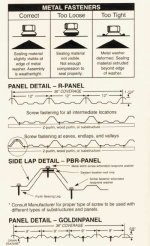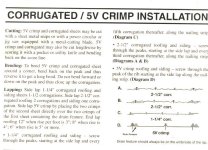texasjohn said:All I can say is that I gave you my actual experience. The screws (actaully were not self taping... my mistake... , but had pointy ends) were installed on the flats and on the ridges only at edges. They pulled out by the hundreds... but only after 10+ years, beyond warranty range. They did have rubber washers under them but since I didn't do the installation, I can't tell you if they were tightened properly or not. When they do pull out, water rushes in. Anybody who has a permanent solution for my current problem... I'm listening.
I knew there were differing and strong opinions when I first posted.
Yes, Eddie, I seem to recall that the roofs in Latin America were the corrugated type, no flats.
Check out this company: SFS intec Weather Gard®: Products for the metal building industry
They are a supplier to the metal roofing industry and have larger sized screws that may be used to replace those that have pulled out. If you have a metal distibuter in your area that deals mostly with the pros, they should be able to order them for you. If you can't find them, pm me.


